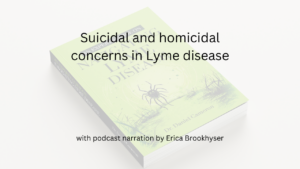Call for your appointment today 914-666-4665 | Mt. Kisco, New York

Welcome to an Inside Lyme case study. I find that the best way to get to know Lyme disease is through reviewing actual cases. In this case study, I will be discussing a 74-year-old woman with a tick bite with Lyme disease, Babesia, and Anaplasmosis. This case series will be discussed on my Facebook and made available on podcast and YouTube.
In this episode, I will be discussing a 74-year-old woman with a triple tick attack.
This case was described in the journal Cureus, written by Kumar and colleagues in 2019.
A 74-year-old woman had underlying medical problems. She was a smoker with chronic obstructive pulmonary disease (COPD). She also had hypertension. She was initially treated for pneumonia with ceftriaxone and azithromycin. She was also treated for Babesia.
Her red blood test contained parasites typical of Babesia. That is, they were able to see a parasite typical of Babesia under the microscope. Babesia is a disease from a parasite found in a deer tick. This is the same deer tick that carries the spirochete that causes Lyme disease. Over 9% of her red cells contained parasites typical of Babesia.
The doctors added atovaquone for Babesia. Atovaquone is marked under the name Mepron in the US. The doctors also added doxycycline over concerns that the woman might also be infected with Lyme disease. She was quite ill. She was also placed on a respirator. She required medications to raise her blood pressure.
The doctors prescribed erythrocytapheresis due to the severity of her illness and the high number of parasites in her red cells. During erythrocytapheresis, some of the red blood cells are removed and replaced with blood from a donor. The number of parasites dropped from 9 to 5.54 percent, but the woman remained in shock. Her kidneys function worsened, which was believed due to hemolysis.
The woman’s blood test was positive for Lyme disease and Anaplasmosis.
[bctt tweet=”There have been a number of studies showing three or more pathogenic infections in the same tick.” username=”DrDanielCameron”]
The doctor made one last antibiotic change. The doctors changed the treatment for Babesia from atovaquone and azithromycin to clindamycin and quinine. Clindamycin and quinine are still used for difficult to treat cases of Babesia. She improved enough to take her off the respirator. Her blood counts and kidney function returned to normal after 14 days of treatment.
There have been a number of studies showing three or more pathogenic infections in the same tick. “The incidence of a three pathogen infection is rare” writes Kumar. In actual practice, I have seen individuals with three pathogens who have not been published.
I support the Kumar’s call for a low level of suspicion; “A low threshold for suspicion should be held for a co-infection when patients exhibit a presentation that would be atypical for single pathogen exposure. A delay in diagnosis can lead to prolonged disease duration and increases the comorbidities associated with the infectious state.”
I agree with the doctor’s concerns with the reliability of testing for Babesia. Kumar writes, “A blood smear is the gold standard for the diagnosis of Babesiosis, however, if a patient has a low level of parasitic load, PCR is more sensitive.”
Kumar also raised concerns about the reliability of testing for Anaplasmosis. Anaplasmosis has been seen in red cells in some patients. “PCR and serological testing are also available, which are more sensitive than a thin smear.”
Finally, Dr. Kumar advised a longer course of treatment for Babesia. “In case of immunocompromised individuals who are at risk of relapsing Babesia, treatment for a total of six weeks is preferred, including a period of two weeks after parasites are no longer visible on a thin smear” writes Kumar.
What can we learn from this case?
- It is important to look for a tick-borne infection even in patients with an underlying illness.
- Patients can suffer from more than one tick-borne infection at the same time. In this case a tick bite with Lyme disease, Babesia, and Anaplasmosis..
- Their illness can be severe.
What questions does this case raise?
- Would Babesia have been discovered without seeing the parasite under the microscope?
- What is the best combination of treatment and length of treatment to prevent long-term complications in a woman with a tick bite with Lyme disease, Babesia, and Anaplasmosis.?
Treating Tick-Borne Disease
We need more doctors with skills diagnosing and treating individuals with more than one tick-borne infection. We could use a reliable test to determine who has a tick-borne infection and when tick-borne infections have resolved. We need to determine the best course of treatment to prevent chronic illness. We hope a professional can use this case to remind them to look for more than one tick-borne infection and treat them accordingly.
We also need to give doctors the freedom to treat these difficult cases without undue interference by colleagues, insurance companies, medical societies, and medical boards.
Inside Lyme Podcast Series
This Inside Lyme case series will be discussed on my Facebook and made available on podcast and YouTube. As always, it is your likes, comments, and shares that help spread the word about this series and our work. If you can, please leave a review on iTunes or wherever else you get your podcasts.
Sign up for our newsletter to keep up with our cases.
References:
- Kumar M, Sharma A, Grover P. Triple Tick Attack. Cureus. 2019;11(2):e4064.




I had 7 bulls eye rashes and was hit several times as well as my dogs had the engorged ticks. This was due to a leak in the AC drain into the plumbing line that unknowingly filled the foam under the bamboo flooring. I was really sick but due to a swift diagnosis by my infectious disease doctor I was put on Alinia and Doxycycline. I was diagnosed with Morgellons as well.
great outcome.
Is it possible to get Lyme from a spider or other small bug bite? No bullseye. Very sick that night, couldn’t stand up. Temp 102 in doctor’s office the next day. He started me on an antibiotic. Which made me sick. Two weeks later a Lyme disease tested positive.
The research funds dried up after the identification of the tick. There are Lyme disease rashes that can look like a spider bite. Finally, there are Lyme disease cases where you never see the tick.